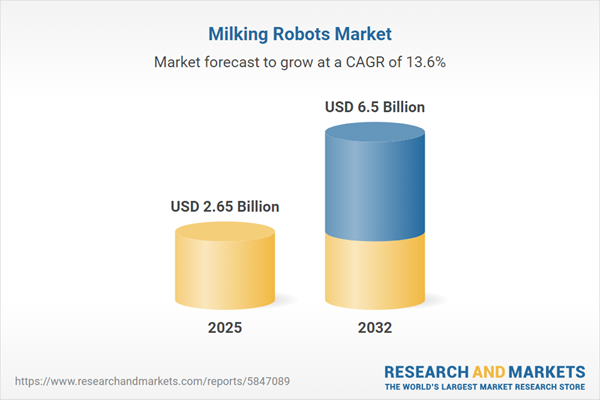Speak directly to the analyst to clarify any post sales queries you may have.
The milking robots market is transforming dairy operations, providing senior leaders with purposeful strategies to increase operational efficiency, leverage advanced automation, and ensure adaptable management in a shifting industry landscape. Digital solutions and robotics are setting new benchmarks for modernization in dairy production, equipping organizations to respond to evolving expectations and regulatory environments.
Milking Robots Market Snapshot
The global milking robots market is on an accelerated growth trajectory, expanding from USD 2.34 billion in 2024 to USD 2.65 billion in 2025. With a compound annual growth rate of 13.59%, investment momentum remains strong as dairy businesses embrace automation to reshape traditional operational models. Automation is influencing everything from facility layouts to workforce tasks, while digital herd management platforms and compliance requirements are setting more transparent practices across organizations. In this dynamic sector, demand for actionable analytics is guiding executive teams to continually refine and optimize technology investments, with a focus on operational agility and long-term competitiveness.
Scope & Segmentation of the Milking Robots Market
This report structures its analysis to support executive decisions by mapping the distinctive opportunities available within the milking robots market. Segmentation aligns with ongoing industry priorities and investment interests, presenting essential categories for stakeholders:
- Product Types: Arm robots and cabin robots drive automation at multiple operational scales, ideal for enterprises seeking to streamline or expand their processes.
- System Types: Lateral, parallel, and rotary systems accommodate differing facility layouts and requirements, creating upgrade pathways for new and established dairy environments.
- Herd Sizes: Automated solutions are purposely adaptable for small, medium, or large herds, making it possible for investments to align with a variety of organizational structures and business models.
- Distribution Channels: Dealer networks, direct sales channels, and digital acquisition paths grant organizations—ranging from regional producers to global cooperatives—access to tailored solutions for diverse operational needs.
- Component Categories: Sensors, actuators, analytics modules, and service frameworks are integrated to provide the foundation for real-time management and continuous operational insight.
- Installation Types: New build and retrofit installation options permit phased introduction of automation, supporting business continuity and minimal disruption during implementation.
- Regional Focus: The Americas, Europe, Middle East and Africa, and Asia-Pacific are covered to address differences in operational environments, regulatory frameworks, and investment drivers unique to each geographic area.
- Company Landscape: Leaders such as Lely Industries N.V., DeLaval International AB, GEA Group Aktiengesellschaft, BouMatic LLC, Allflex Europe NV, Afimilk Ltd., Insentec B.V., and Fullwood Packo plc influence innovation and reinforce competitive standards across the industry.
Key Takeaways: Strategic Insights for Senior Leadership
- Automated health monitoring and digital visibility solutions enhance internal alignment and streamline communication with all stakeholders.
- Phased deployment of automation allows organizations to manage change with reduced risk and support a smooth digital transformation process.
- Regional partnerships provide improved access to service infrastructure, enabling consistent performance across varying operational settings.
- Adoption of data-driven herd management tools strengthens proactive monitoring and supports ongoing operational improvement.
- Prioritizing workforce integration alongside automation and supply chain enhancements helps organizations remain resilient in fluctuating market environments.
- Collaboration with robotics experts, technology providers, and industry consultants increases efficiency and effectiveness through every stage of the dairy production chain.
Tariff Impact on Supply Chain Structures
In the United States, new tariffs on imported robotic components are causing organizations to reconsider supply chain strategies and sourcing practices. This regulatory change is guiding companies to invest more in localized service and logistics, supporting both compliance with shifting international trade requirements and operational stability for domestic operations.
Methodology & Data Sources
This research report applies a comprehensive approach by blending in-depth literature reviews, direct interviews with subject matter experts, and detailed supply chain analysis. Senior decision-makers benefit from credible and relevant data, enhancing both strategy development and procurement process management throughout the automation journey.
Why This Report Matters
- Senior executives gain practical insights to prioritize automation and identify segment-specific technology opportunities aligned with their strategic objectives.
- Benchmarking tools and trend analysis support robust procurement and operational planning to address evolving market demands.
- Decision-making is bolstered by validated forecasts and actionable compliance guidance, ensuring organizations can adapt smoothly to changing operational and regulatory conditions in the sector.
Conclusion
With sector-specific analytics and expert insights, this report empowers leadership teams to craft automation strategies that reinforce both resilience and adaptive capability in today’s evolving dairy technology market.
Additional Product Information:
- Purchase of this report includes 1 year online access with quarterly updates.
- This report can be updated on request. Please contact our Customer Experience team using the Ask a Question widget on our website.
Table of Contents
3. Executive Summary
4. Market Overview
7. Cumulative Impact of Artificial Intelligence 2025
Companies Mentioned
The companies profiled in this Milking Robots market report include:- Lely Industries N.V.
- DeLaval International AB
- GEA Group Aktiengesellschaft
- BouMatic LLC
- Allflex Europe NV
- Afimilk Ltd.
- Insentec B.V.
- Fullwood Packo plc
Table Information
| Report Attribute | Details |
|---|---|
| No. of Pages | 191 |
| Published | October 2025 |
| Forecast Period | 2025 - 2032 |
| Estimated Market Value ( USD | $ 2.65 Billion |
| Forecasted Market Value ( USD | $ 6.5 Billion |
| Compound Annual Growth Rate | 13.5% |
| Regions Covered | Global |
| No. of Companies Mentioned | 9 |









